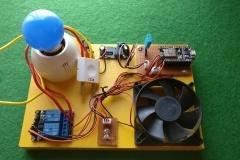- Module 2 – Arduino Basics – 15 ~ 17 Hours
Pre-requisite for this module:
- Understanding of Basic Electronics, Usage of electronic components in circuits, usage of bread boards
- Good introduction to the embedded systems
- It is strongly recommended that students bring their own laptop. You’ll preserve your work and you’ll have all the development environment set up for you to work even after your course(s)
Working Kit Contents:
- Arduino Uno Board, DC Motor, Servo motor, 8x8 Dot Matrix Display, 16x2 Character LCD display, Breadboard, LEDs, RGB LEDs, Resistors, Potentiometer, 7-Segment Display, Tactile switch, Rocker switch, Piezo Electric Buzzer, Connecting Wires, Batteries
What you’ll learn:
- Basics of Arduino open source hardware, its development environment and programming language
- Understanding what a microcontroller is and how it can used in practical applications
- How various display devices, electro-mechanical devices and input devices can be interfaced with AVR microcontroller and how they can programmed for practical usage
- Understanding how Pulse Width Modulation (PWM) can be used to vary the speed of DC motor or fade an LED.
- What is a Microcontroller? – 1 Hour
- What it is? How it operates? What role does crystal play?
- Differences between Microcontroller and Microprocessors and how to choose for any given application?
- Basic presentation on Arduino microcontroller platform – 1 Hour
- Learn about Arduino’s Digital/Analog inputs/outputs, programming interface and how software can be downloaded. Understand about internal pull up resistors and their use
- Atmel AVR 168/328 Microcontrollers
- Learn usage of Arduino programming language (which is very similar to popular ‘C’ language)
- Learn how to use the Arduino IDE. How to install/manage libraries, use serial port.
- What it can do and how it can used as a basic robotic platform.
- Basic usage of Arduino AVR microcontroller platform.
- Hands-On Projects:
- Blink an LED – 30 Mins
- Using software delay
- Detect a switch press - 1 Hour
- Using software polling
- Using external interrupt
- Understand PWM (Pulse Width Modulation) – 30 mins
- Fade an LED using PWM - 30 mins
- Interface an RGB LED and display various color combinations - 1 Hour
- Implement a 4 bit counter using four LEDs – 1 Hour
- Interface a 7-segment display and run a counter from 0 to F - 2 Hours
- Have a switch which will toggle between Up and Down counting while pressed
- Interface Servo motors - 30 mins
- Learn how servos work and their practical uses
- Interface a DC motor and run the motor forward for 3 seconds and reverse for 3 seconds and stop - 5 Hours
- Learn how to interface and use H-Bridge L293 board to change direction of DC motors.
- Fade an LED according to the detected value of potentiometer resistance – 1 Hour
- Blink an LED using millis() – 1 Hour
- Understand the concept of interrupts and timers
- Interface a 16x2 Character LCD display –1 Hour
- Using LCD library
- Interface a 8x8 Dot Matrix LED Display - 3 Hours
- Write code to drive this display using MAX7219 driver.
- Cascade multiple of these displays and scroll messages.
- Blink an LED – 30 Mins
















